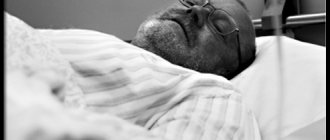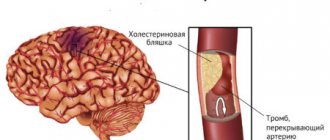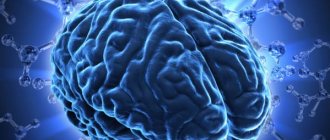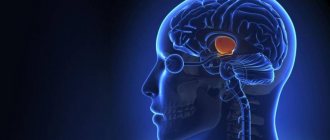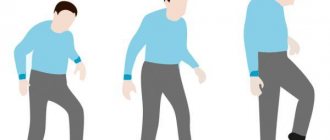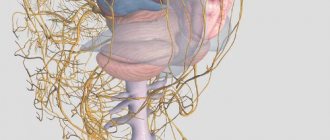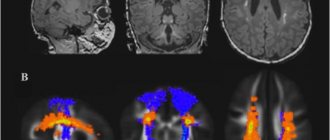General nature of causes and etiology
The causes of psychogenicity lie in psychological trauma of varying severity.
An individual’s experiences can be acute or chronic, characterized by a state of shock, depression or anxiety. In many ways, the course of the disease and the patient’s condition are determined by the severity of the injury and the degree of mental instability. A person who is sensitive by nature to emotional shocks experiences this condition much more difficult than someone whose psyche is more stable.
More often, psychogenic disorders occur in vulnerable and infantile people who react sharply to what is happening, as well as in people with mental retardation.
In addition, unfavorable life circumstances, the death of loved ones and long-term family troubles, a humiliating position of a person or awareness of physical deformity and inferiority can give impetus to the development of mental disorders. In this case, the disease develops slowly, gradually reducing vitality and leading the individual to a state of apathy.
It is not possible to find out how widespread such a disorder is, since many people do not assess their condition as painful, considering what is happening as a “everyday situation” and a “dark streak.”
However, it is safe to say that cases of the development of psychogenicity become significantly more frequent during mass upheavals in the form of wars and natural disasters.
Stupor causes, methods of diagnosis and treatment
There are more than 10 types of torpor - the differences lie in the primary source of the lesion and the course of the symptom. Depending on the type of pathology, an effective course of treatment or medication schedule is also selected. Any form of stupor has common symptoms - muscle tension, clouding of consciousness, immobility, increased body tone, silence, weakening of natural reflexes.
Catatonic stupor
Catatonic disorder usually occurs due to severe fear, danger, an emotionally elevated state of affect, autism, postpartum or post-traumatic depression, or an overdose of antipsychotics. Manifests itself in three stages:
- Pathetic - a slight limitation of mental and motor abilities without clouding of reason.
- Impulsive - an acute sudden manifestation of symptoms with a risk of threat to others and the patient himself.
- Silent - numbness of the body with disordered thinking and an aggressive attitude.
Emotional stupor
Appears after a severe psycho-emotional shock, witnessed grief or a shocking event. The medical name for the symptom is a state of passion. The patient can cause physical harm not only to others but also to himself, and therefore needs constant monitoring.
Mental block
Characteristic of people with a fine mental organization, vulnerable and sensitive individuals. The emotional level of such patients is higher than that of the average person. Most often these are creative people, teenagers during puberty, women during pregnancy or menopause. The symptom manifests itself in the form of apathy, prolonged melancholy, and creative crisis.
Jet Stupor
A psychogenic form of the disorder, which can occur either as an independent mental disorder or as a result of prolonged reactive psychosis. Characteristic signs are absolute mutism and immobility. The patient is silent, does not move, does not react to any stimuli.
Apathetic stupor
Other terms are asthenia or waking coma. A patient with damage to motor and mental functions is in complete apathy, most often in a lying position. The patient is not interested in anything, ignores hunger, thirst, and natural needs.
Manic stupor
The exact opposite of numbness - the patient is in heightened arousal, which manifests itself in all reflexes and abilities:
- good mood, laughter, fun even with severe grief;
- rapid acceleration of the ability to speak and think;
- sudden chaotic movements of all parts of the body;
- increased feelings of hunger, thirst, pain, desires.
Other types of stupor
- Catapleptic - numbness with waxy flexibility without complete immobility.
- Hebephrenic - complete lack of response to external factors, speech and sensations;
- Hysterical - apathy with loud crying, screaming, hysterics, unreasonable laughter.
- Depressed - numbness due to emotional shock, the patient refuses food and water, and may harm himself.
- With muscle numbness - position in a tense position of the embryo without any reflexes.
- Negativistic - the patient is immobilized, but retains reflexes, and when trying to “stir up” he resists.
Complex of psychogenic disorders
The reaction to unfavorable external factors largely depends on the individual characteristics of the person and the specific situation as a result of which the disorder developed. For this reason, it is quite difficult to identify a clear classification of psychogenic diseases.
In general, the following conditions fall under this definition:
- reactive delusions (paranoid);
- pathological reactions;
- reactive type excitation;
- state of psychogenic stupor;
- state of affective-shock psychosis;
- psychogenic depression;
- reactive psychosis of hysterical type;
- twilight disorder of consciousness;
- various types of neuroses;
- post-traumatic stress disorder.
In order to most specifically determine this or that form of psychogenicity, it is necessary to understand on what basis the disorder developed. In addition, due to the individual characteristics of the psyche, the same type of disease can manifest different symptoms in different people.
Each type of disorder manifests itself with certain signs, which makes it possible to identify one or another type of mental disorder.
Jet nonsense
Reactive delusional psychosis is characterized by anxiety, increased excitability and motor activity, as well as the appearance of delusions.
The appearance of auditory hallucinations is possible. Often such a violation is observed in persons in places of deprivation of liberty, in conditions of solitary confinement. Also, people who suffer from this type of disorder after long and tiring journeys (railway paranoid) or who abuse alcoholic beverages.
This condition can last from several weeks to 2-3 months, and medical care in this case is extremely necessary.
Pathological reactions
In such cases, the violation manifests itself in the form of an inadequate, too violent reaction to what happened. The reason may not be traumatic, sometimes it is completely insignificant. The pathological reaction, as a rule, is short-term in nature, and the duration of the attack depends on the degree of mental instability and the individual characteristics of the patient’s body.
Also, a similar condition can occur in people with visual and hearing impairments when they find themselves in an unfamiliar environment.
This phenomenon is called situational paranoid.
Reactive type excitation
The disease manifests itself as chaotic motor activity, which is subsequently replaced by inaction and complete indifference to what is happening.
The patient may scream and rush around, try to harm himself, and then fall into apathy. It is also common to experience confusion, memory loss and complete amnesia.
Psychogenic stupor
In such a situation, the individual is inhibited and unkempt, there is no appetite and interest in the world around him. The patient does not react to what is happening and does not show motor activity. With psychogenic stupor, cases of sharp vegetative deviations are not uncommon.
Affective-shock psychosis
Affective-shock psychosis appears due to acute shocks, for example, severe fear during an accident or during natural disasters, sometimes from unexpected sad news.
In this state, a person can be overly excited, performing many meaningless and useless actions, or, conversely, fall into a stupor. Often patients subsequently cannot remember what happened to them at that moment.
People with increased sensitivity, as well as in conditions weakened by previous mental shocks, are most susceptible to affective-shock reactions. A person can remain in this state for up to 1 month.
Psychogenic depression
Psychogenic depression is the most common of all psychogenic spectrum disorders.
This deviation is characterized by increased tearfulness, depression, anxiety and fear. The patient may be lethargic, or, conversely, be overly excited. All a person’s thoughts are subordinated to the event that occurred, which was the cause of mental deviation; suicidal attempts are possible.
Often, against the background of depression, disturbances occur in various body systems, and chronic diseases become aggravated. A person can remain in this state for 1–3 months, and for persons over 40 years of age much longer.
Reactive psychosis of hysterical type
Psychogenic disorders of the hysterical type are of several types:
- Pseudo-dementia (false dementia) . The main distinguishing feature of “false dementia” is the person’s appearance - a meaningless expression on the face, depression or laughter for no reason, and tremors of the limbs are also observed. In communication, such a person is inadequate, often answers inappropriately and gets confused, but at the same time he is able to give the correct answer to quite complex questions. In everyday life, the same thing happens - the patient can lose basic skills and at the same time adequately use, for example, household appliances.
- Puerilism . With puerilism, a person seems to “fall into childhood.” His facial expressions, behavior, speech and reactions correspond to those of a child; the patient may be capricious, cry, and also play children's games and consider himself a child.
- Ganser syndrome . In a condition related to the manifestations of Ganser syndrome, patients lose the ability to perform everyday manipulations and simple actions (for example, they cannot turn off the light or water). At the same time, they deliberately give incorrect answers to simple questions, become inhibited or become very excited.
These forms of the disease can develop independently, but more often there is a transition from one type of psychosis to another.
Twilight disorder of hysterical type
This type of mental disorder is associated with traumatic situations and is manifested by a hysterical state that turns into a stupor or trance.
A person can commit ridiculous actions, suffer from hallucinations about the situation that happened, and see vivid images. In addition, the patient is unable to remember the current date and realize where he is.
After a person’s condition stabilizes, he does not remember what happened to him during the exacerbation period.
Neuroses
A neurotic disorder can be triggered by prolonged stress and mental trauma.
Often occurs as a result of a feeling of psychological discomfort in the environment where a person is located.
In a state of neurosis, the patient realizes that disturbances are occurring in his psyche and he is unhealthy.
Post-traumatic stress disorder
This condition is associated with severe shocks: death of loved ones, catastrophes, natural disasters and others. Once the traumatic situation is resolved, the patient can fully recover.
But often the consequences of this disorder are nightmares and memories of the event.
Medical educational literature
Hysterical twilight states (the most common variant) occur in individuals suffering from hysterical psychopathy. They are manifested by clouding of consciousness according to the type of its pathological narrowing with more or less gross disorientation in place, time and surrounding persons, motor agitation and the presence of complex (usually auditory and visual), often achromatic hallucinations. In a state of darkened consciousness, the patient experiences these hallucinations in the form of a coherent plot (in the center of which he is usually himself) and behaves according to these complex experiences. Sometimes these hallucinatory images are experienced by the patient in a diametrically opposed way to his actually severe psychotraumatic situation.
For example, a woman who was waiting for her husband to return from the front or at least a letter from him, having received a funeral, falls into such a twilight state and waits for her husband, who (in her painful imagination) is about to return safe and sound, “hears” his steps, his voice “sees” him, enters into a conversation with him, etc. The course of this state is wave-like, since from time to time the depth of stupefaction decreases, motor excitation subsides, the patient returns to approximate orientation, but then he again falls into the previous state. psychotic state. Lasts from several days to 2-3 weeks, ending with the restoration of mental health.
Twilight states with speech incoherence can occur in both hysterical and other, non-hysterical individuals. In the latter case, they usually arise acutely and against the background of a pathologically narrowed consciousness with disorientation and motor agitation, a peculiar - psychogenic speech confusion - appears. Speech flows in a stream and consists of incoherent words, sometimes even unfinished; interjections, exclamations, reflecting the patient’s affective tension and traumatic experiences. Usually this picture lasts from several hours to 2-3 days and then the patient emerges from the twilight state through severe asthenia.
But such psychogenic speech confusion can also be observed within the framework of a more prolonged hysterical psychosis, i.e., manifest itself in the form described above as a symptom in the process of a hallucinatory plot experienced by the patient against the background of twilight stupefaction with disorientation. It can occur for a short time and in situations of activation of psychogenicity, additional psychotraumatization in the structure of various acute and subacute reactive psychoses.
Pseudo-dementia
This form of subacute reactive psychoses manifests itself in the patients’ incorrect answers, which are distinguished by great absurdity, as if demonstrating their gross dementia. The behavior of the sick turns out to be just as deliberately absurd. Thus, he defines a robe as a coat, calls a door a window, etc. The peculiarity of such answers is that, being grossly incorrect, they remain in the context of the question posed and mean that the patient has, to a certain extent, a correct idea of the given situation or purpose subject. This symptom was aptly called transience. The wrong actions of patients are similar to this: when asked to light a match, the patient strikes the box with the shaft, and not with its head; when getting dressed, he puts his leg into the sleeve of his shirt; when asked to show the nose, shows the chin, etc. These are the so-called passing actions, which also show that the patient generally retains an idea of the correct structure of the action proposed to him, but does not perform it, but a motor act adjacent to it. Mimospeech and mimaction are two of the most characteristic symptoms of pseudodementia. Two clinical variants of pseudodementia are identified: agitated and depressive [Felinskaya N.I., 19681.
With depressive pseudodementia, the picture of the disease is formed gradually against the background of anxious-depressive affect and motor and speech retardation. Patients are inactive, passive, mostly lie down, answer questions with a delay, and have a pained expression on their face. More often they give incorrect answers to the interlocutor’s questions (such as passing), but often they give a negative answer “I don’t know”, “I don’t remember”, etc. The same thing happens in the behavior of patients: the symptom of passing is expressed rudimentarily, more often patients simply refuse this, they ask to leave them alone.
With the agitated variant of pseudodementia, patients are active, usually mobile in the department, make many unnecessary movements, i.e. motor disinhibition is detected. The patient’s face expresses surprise, sometimes fear, and amusement against the background of the patient’s foolish carelessness and abundantly manifested symptoms of fleeting words and inaction. In contact with the interlocutor, he gives answers that are opposite in meaning to the content of the psychotrauma. Thus, being arrested for theft, he claims that he is free, respected and even honored, etc. At the same time, the patient’s speech is profuse and inconsistent. During the process of reverse syndromekinesis, i.e., recovery from pseudodementia, episodes of delusional fantasies are possible. The duration of pseudodementia ranges from several weeks to many months.
Puerilism, as one of the characteristic forms of reactive psychoses, is manifested by a childish form of speech, behavior and emotional reactions, i.e., as if by a regression of the psyche to a child’s level. And indeed, the patients speak in a childish, lisping voice, with childish intonations; they call those around them “uncle” and “auntie,” and declare that they are 5 or 6 years old. They walk with small steps, run and generally move like children, reaching for shiny objects, grabbing them, starting to play with them or, on the contrary, hiding and carrying them away, etc. While walking in the hospital yard, men “sit astride” on a branch, the other is “chased”, imitating riding a “horse”; women collect candy wrappers and colored threads, small rags, pretending to play with dolls. Emotions also have a childlike pattern: patients are offended by comments, pout their lips, “roar” when “toys” are taken away when returning from a walk to the department, etc. And yet we are not talking about a complete regression of the psyche to a child’s level, since in Within the framework of the described childhood pattern of behavior, the patient may light a cigarette and shave, which reflects the inclusion of components of adult behavior in this psychopathological picture.
Mental regression syndrome (feralization) manifests itself in the loss of the patient’s usual higher mental forms of behavior and his transition to behavior that imitates the behavior of an animal or a person who has completely lost his mind. Patients move on all fours, become aggressive, lap up food directly from the bowl, are unable to use a spoon, sleep on the bare floor, curled up. In cases of motor excitation, the patients' movements are chaotic and lack purposefulness. Sometimes this picture is “enriched” by the “reincarnation” syndrome, when patients bark like a dog, growl at those around them, bare their teeth and try to bite; they lap up food and water (“drink”) directly from the bowl, then raise their head and close and open their mouth, as if imitating a bird’s drinking, flapping their hands in the manner of a bird’s wings, etc. Feralization syndrome can immediately present a picture of reactive psychosis, which happens rarely. More often it seems to complete a whole series of psychogenic syndromes that transform in the dynamics of a reactive illness.
Delusional fantasies
The syndrome of delusional fantasies may exhaust the picture of this reactive state, but more often it is the initial or (less often) final stage of a reactive illness with repeated transformation of psychopathological syndromes. More often it occurs in mental retardation or psychopathic individuals. Its psychopathological structure is represented by unstable, absurd delusional ideas of greatness, wealth, social significance, special origin, and often fantastic content. When communicating with others, patients report on their adventures, participation in battles, treasures found, etc. The theme of such statements sometimes follows from their own absurd, sometimes pseudo-dementia answers, but is often easily inspired by the interlocutor’s questions. The mood background turns out to be alarming. As the syndrome is reduced, these delusional fantasies fade, acquire the character of stereotypical repetition and then completely disappear. Sometimes at this stage of reverse syndromekinesis the patient’s condition is fixed for a long time. Upon recovery from psychosis, partial amnesia is possible.
Psychogenic stupor
Psychogenic stupor rarely occurs as a primary reactive syndrome immediately after exposure to mental trauma; more often it is one of the later stages of a reactive disease, mainly the final stage of its progressive development. It manifests itself as motor retardation and mutism, usually combined with muscle hypertension. Depending on the severity of symptoms, incomplete stuporous pictures are possible - substuporous states, when patients still make (very slowly) a limited number of movements and can quietly pronounce some individual words. When the stuporous state is fully expressed, patients are completely immobilized, are not capable of speech contact, cannot eat themselves, and are unkempt. In contrast to catatonic states of other (infectious, organic, schizophrenic, etc.) origin, patients with psychogenic stupor are fixed in affective-expressive motor inhibition. In their facial expressions (and sometimes pantomimical expressions), despite intense inhibition, sadness and suffering are revealed, and questions of a psychotraumatic nature, although they remain unanswered, cause vivid vegetative reactions in the form of tachycardia, uneven pulse rate, breathing, “local” hyperemia of the skin face and other manifestations.
If you find an error, please select a piece of text and press Ctrl+Enter.
Pages: 2
Features of psychogenic disorders in children and adolescents
Any of the listed types of mental disorders may occur in childhood and adolescence. The difference is that a fragile child’s psyche can react to traumatic situations more acutely, but recovery in children with proper treatment is faster.
Factors that indicate a child or adolescent’s predisposition to the development of psychogenics include the following features:
- anxiety and suspiciousness;
- increased excitability;
- impressionability and sensitivity;
- infantilism;
- tendency to worry and unreasonable fears.
The personality characteristics of a child largely determine the type of disorder that may arise in a stressful situation.
For example, children suffering from increased anxiety are more prone to neurotic disorders of overvalued content, and an easily excitable child reacts to mental trauma with manifestations of the hysterical type.
Complex of therapeutic measures
In the process of treating psychogenics, it is important to establish the cause of the disorder and take measures to eliminate circumstances that are traumatic to the psyche.
Patients are most often hospitalized because they exhibit unpredictable behavior and can be dangerous to others. In addition, people with mental disorders are often suicidal. For this reason, medical supervision is necessary.
In some cases, just a change of environment has a beneficial effect on a person, but this is not enough for recovery. During the treatment, medications are used, such as:
- tranquilizers;
- antidepressants;
- neuroleptics;
- sedatives.
If the patient is overly excited, it is advisable to use the following drugs for intramuscular administration:
- Phenazepam;
- Tizercin;
- Aminazine;
- Diazepam.
The drugs should be administered 2-3 times a day, and drug therapy should be continued until the patient’s adequate condition is restored.
In addition, patients need psychotherapeutic influence. This is necessary for the psychological, social and labor adaptation of the victim.
The duration of treatment depends on the severity of the condition and the individual characteristics of the patient. In some cases, 10 days of hospital treatment is enough for a person, but in other situations, recovery takes 2 or more months.
Implications for general health
Our psyche is sometimes unpredictable, and the same applies to prognoses for various disorders. The chances of recovery and possible consequences directly depend on the situation that caused the mental disorder, as well as on the individual characteristics of the body.
In addition, one should not miss such a moment as the timeliness of assistance - the earlier treatment is started, the higher the chance of a favorable outcome.
In some cases, the patient fully recovers from the shock, but it also happens that what happened leaves a mark for life.
In addition, psychogenic and reactive mental states can cause somatic diseases, for example:
- disruption of the gastrointestinal tract;
- problems with the respiratory system;
- heart and vascular diseases;
- enuresis and difficulty urinating;
- hormonal imbalances.
Also, as a result of mental disorders, frigidity occurs in women, and impotence in men.
Etiology of development and risk factors
The pathogenesis of psychogenic diseases is based on severe mental shock. But psychotrauma does not cause illness in every person.
More often, reactive psychosis is detected in accentuated individuals with pronounced character traits that are within normal limits, but border on pathology. Also emotionally vulnerable - unstable, highly reactive, hysterical, paranoid people.
There are risk factors that are most likely to develop psychogenic disorders:
- neuropsychic weakness, impotence, fatigue (asthenia);
- traumatic brain injury (TBI);
- genetic predisposition;
- severe somatic and infectious diseases;
- physiological changes in hormonal levels (puberty, pregnancy, childbirth, menopause);
- gender (women get sick more often than men);
- intoxication of the body (alcohol, drugs, medicinal substances);
- vitamin deficiency, especially lack of vitamins B1 and B3.
Article on the topic: Consequences of ectopic pregnancy - signs and risk factors for complications
The likelihood of detecting the disease in a child whose family suffers from psychosis is very high.
